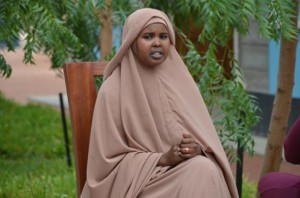Student crosses border for a third time in pursuit of education
As she lay in bed waiting for sunrise, Rahma Hussein Noor (pictured) had already made up her mind. She wouldn’t let her hopes and dreams remain buried deep inside her.
She was determined to live life on her own terms. So at sunrise, she left her father’s house and crossed the border for a third time, and returned to a more familiar life. The problem though, was that her previous life didn’t really want her. Neither did it expect her back. Rahma and her family fled Somalia in 2009. Their search for safety led them to Daadab Refuge Complex where they were to spend the next six-year phase of their lives. “For a while life was good at the camps. There was no threat of bombings or arbitrary killings,” Rahma says. Then in 2013, the government, the UNHCR and the Somali government set in motion events that would encourage Somali refugees to go back to their country. Two years later, in August 2015, Rahma’s father decided to take them back home and start over a new leaf. After all, they had a home to go back to. READ MORE Aid cash barons sad over refugee camps’ closure Court acquits man convicted of sodomising 15-year-old Woman to hang for burning grandson over Sh5 jaggery theft “He just told us to pack up and we were on the next flight to Mogadishu,” Rahma says. That same year, she was to sit her KCSE examinations. Rahma is just one of the many refugees whose education will be disrupted by the ongoing repatriation programme. “We have students who have been through the 8-4-4 system since birth. What system will they use once in Somalia?” Jennifer Katiwa of education non-governmental organisation Windle Trust asked The Standard on Sunday. Currently, her organisation employs more than 240 teachers spread across the five camps in Dadaab. Their seven schools offer instruction to over 6000 students. The education options east of the Kenyan border may not be palatable for many of the refugees. “First of all, the fee is too high. Here we pay nothing. But in Somalia, it ranges from Sh4,000 to Sh15,000 per term. My father was unable to afford this,” Rahma said. As a sendoff package, refugees receive food rations, medicines as well as a cash incentive of Sh15,000 per person. “With such amounts, school fees is not a priority. Survival becomes the only priority,” she says, adding that for her father, part of the survival strategy included marrying her off. “He said I had to marry for my own protection. He’d rather I got married than get raped,” she says. So she got in touch with former classmates who quickly fundraised for her trip back to Kenya. “Rahma came back for an education. Life on the other side is not the same as at the camps,” Katiwa says. Rahma says that already, a thriving black market has taken root in Somalia. Its main business is to facilitate re-entry of returnees into Kenya
“I was happy my former school took me back,” she says. She hopes to do KCSE exams later in the year. But she might not. She cannot register for the exams as a Kenyan. Neither can she register as a refugee because when her family moved back to Mogadishu, she was struck off the refugee manifest. The refugee manifest is an official document from the UNHCR with all the details of a refugee—age, camp, siblings, kin, date of entry among others. Without it, one cannot qualify for refugee benefits. But she still has hope and continues to be encouraged. On Tuesday last week, she was among the refugees who met Nobel laureate Malala Yousafzai as she visited the world’s largest refugee camp on her 19th birthday. “I am here to speak for my unheard sisters of Somalia striving for education every day,” Malala said. But with the cloud of repatriation hanging over their heads, some say many of the refugees no longer consider education a key passage into a better life? “They do not know whether to continue or leave,” Katiwa says. When the refugees leave, a sprinkling of buildings will be left throughout the camps. Will the host community have enough numbers to fill up these institutions? READ MORE Aid cash barons sad over refugee camps’ closure Court acquits man convicted of sodomising 15-year-old Woman to hang for burning grandson over Sh5 jaggery theft “The secondary schools are also registered as public schools. Will we have enough students to fill the gap? Will the teachers remain?” Katiwa asks. For now, Rahma continues to hold on to her hopes and dreams of striving to live life on her own terms in a country that is really not hers. She, like many others in the same situation, waits for her sunrise, eager to see what new things dawn will bring.
Source:Standard/Kenya
